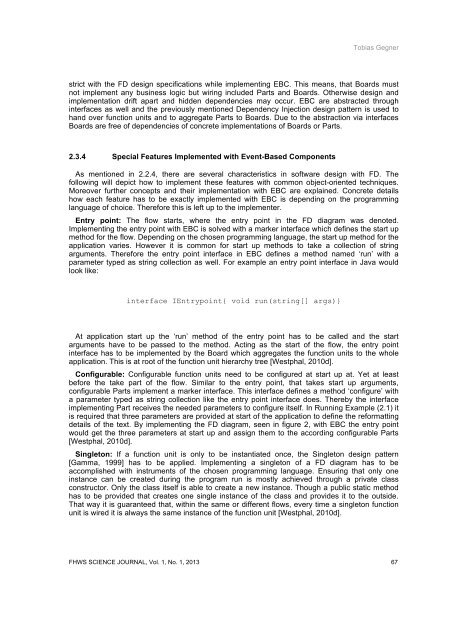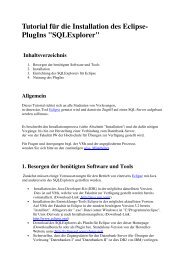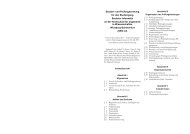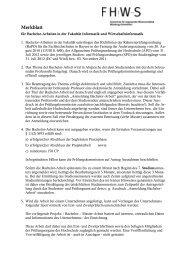FHWS Science Journal - Fakultät Informatik und Wirtschaftsinformatik
FHWS Science Journal - Fakultät Informatik und Wirtschaftsinformatik
FHWS Science Journal - Fakultät Informatik und Wirtschaftsinformatik
Create successful ePaper yourself
Turn your PDF publications into a flip-book with our unique Google optimized e-Paper software.
Tobias Gegner<br />
strict with the FD design specifications while implementing EBC. This means, that Boards must<br />
not implement any business logic but wiring included Parts and Boards. Otherwise design and<br />
implementation drift apart and hidden dependencies may occur. EBC are abstracted through<br />
interfaces as well and the previously mentioned Dependency Injection design pattern is used to<br />
hand over function units and to aggregate Parts to Boards. Due to the abstraction via interfaces<br />
Boards are free of dependencies of concrete implementations of Boards or Parts.<br />
2.3.4 Special Features Implemented with Event-Based Components<br />
As mentioned in 2.2.4, there are several characteristics in software design with FD. The<br />
following will depict how to implement these features with common object-oriented techniques.<br />
Moreover further concepts and their implementation with EBC are explained. Concrete details<br />
how each feature has to be exactly implemented with EBC is depending on the programming<br />
language of choice. Therefore this is left up to the implementer.<br />
Entry point: The flow starts, where the entry point in the FD diagram was denoted.<br />
Implementing the entry point with EBC is solved with a marker interface which defines the start up<br />
method for the flow. Depending on the chosen programming language, the start up method for the<br />
application varies. However it is common for start up methods to take a collection of string<br />
arguments. Therefore the entry point interface in EBC defines a method named ‘run’ with a<br />
parameter typed as string collection as well. For example an entry point interface in Java would<br />
look like:<br />
interface IEntrypoint{ void run(string[] args)}<br />
At application start up the ‘run’ method of the entry point has to be called and the start<br />
arguments have to be passed to the method. Acting as the start of the flow, the entry point<br />
interface has to be implemented by the Board which aggregates the function units to the whole<br />
application. This is at root of the function unit hierarchy tree [Westphal, 2010d].<br />
Configurable: Configurable function units need to be configured at start up at. Yet at least<br />
before the take part of the flow. Similar to the entry point, that takes start up arguments,<br />
configurable Parts implement a marker interface. This interface defines a method ‘configure’ with<br />
a parameter typed as string collection like the entry point interface does. Thereby the interface<br />
implementing Part receives the needed parameters to configure itself. In Running Example (2.1) it<br />
is required that three parameters are provided at start of the application to define the reformatting<br />
details of the text. By implementing the FD diagram, seen in figure 2, with EBC the entry point<br />
would get the three parameters at start up and assign them to the according configurable Parts<br />
[Westphal, 2010d].<br />
Singleton: If a function unit is only to be instantiated once, the Singleton design pattern<br />
[Gamma, 1999] has to be applied. Implementing a singleton of a FD diagram has to be<br />
accomplished with instruments of the chosen programming language. Ensuring that only one<br />
instance can be created during the program run is mostly achieved through a private class<br />
constructor. Only the class itself is able to create a new instance. Though a public static method<br />
has to be provided that creates one single instance of the class and provides it to the outside.<br />
That way it is guaranteed that, within the same or different flows, every time a singleton function<br />
unit is wired it is always the same instance of the function unit [Westphal, 2010d].<br />
<strong>FHWS</strong> SCIENCE JOURNAL, Vol. 1, No. 1, 2013 67








